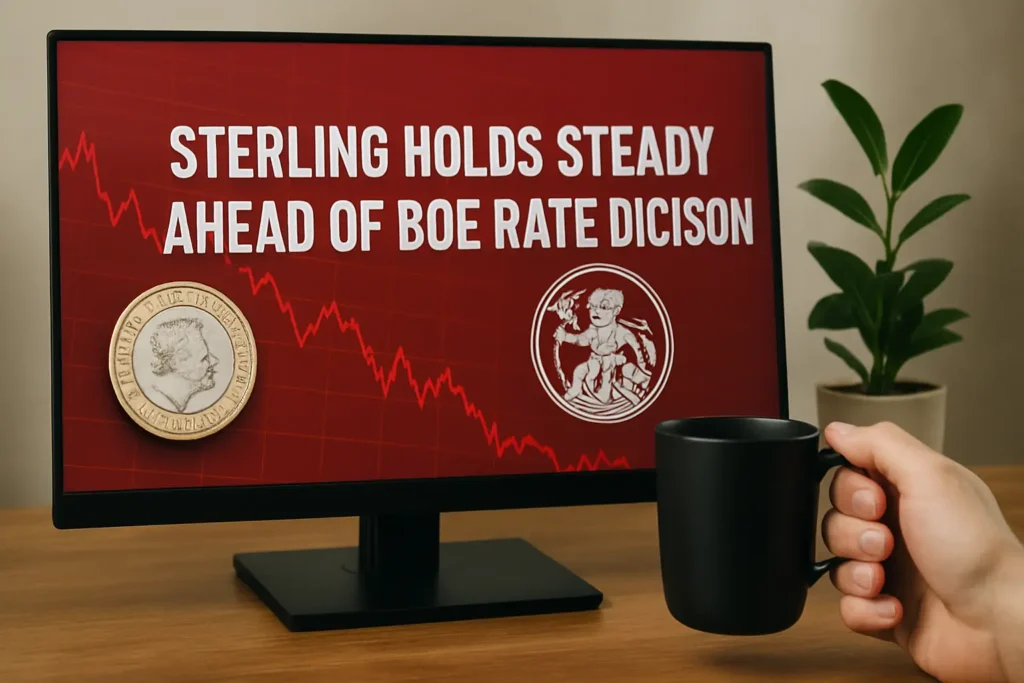The British pound holds steady ahead of the Bank of England’s rate decision. Explore how this could impact global markets, U.S. investors, and currency volatility worldwide.
📰 Introduction: A Pause Before the Storm?
As the financial world holds its breath, the British pound (GBP) — commonly known as Sterling — is treading water. Ahead of the Bank of England’s (BoE) highly anticipated rate decision, the pound is holding steady against the U.S. dollar and the euro, reflecting cautious optimism and deep market uncertainty.
With inflation proving sticky, consumer spending slowing, and the U.K. economy hanging in a fragile balance, investors, traders, and global businesses are closely watching the BoE’s next move.
Will it be another hike? A pause? Or even a signal of easing later this year?
📊 Where Sterling Stands Now
As of the latest trading session:
- GBP/USD is hovering around 1.29, showing slight movement from last week’s close.
- GBP/EUR remains stable near 1.17, with minimal intraday volatility.
- The pound has gained 1.5% in the last month, boosted by strong services data and resilient wage growth.
“Markets are in a wait-and-see mode. No one’s taking big positions until the BoE delivers its verdict,” says Jane Ellis, Head of FX Strategy at BlueRock Capital.
🏦 Why the BoE Decision Matters
The Bank of England’s Monetary Policy Committee (MPC) is expected to announce its latest interest rate decision this week. Analysts are split:
- 53% predict a rate hold at 5.25%
- 47% forecast a 25-basis-point hike
This uncertainty has led to cautious positioning in forex markets, with traders betting on either outcome and hedging against post-decision volatility.
Key Factors in Play:
- U.K. Inflation: Still running at 4.1%, well above the BoE’s 2% target.
- Wage Growth: Strong salary increases are fueling inflation persistence.
- Economic Growth: GDP growth is flatlining, with consumer confidence dipping in recent surveys.
- Global Context: The Fed has taken a hawkish stance; the ECB remains cautious — putting pressure on the BoE to clarify its direction.
📉 What Happens If the BoE Hikes Rates?
A rate hike could:
- Push Sterling higher in the short term.
- Increase borrowing costs, further squeezing U.K. households.
- Fuel expectations of even tighter monetary policy, boosting yields on U.K. gilts.
However, this would come at a cost to growth, especially as housing and energy costs remain elevated.
🧩 And If They Pause?
A decision to hold rates might:
- Weaken Sterling slightly, especially against the U.S. dollar.
- Spark a rally in equities and real estate stocks.
- Indicate that the BoE believes inflation has peaked — or is more worried about growth.
“It’s a balancing act between inflation control and avoiding a hard landing,” notes Marcus Zhang, Economist at Citi Global Markets.
🌍 Why This Matters for Global Markets
Even if you’re not trading forex, the BoE’s decision has ripple effects across the world.
For American Investors:
- GBP/USD affects corporate earnings for U.S. firms with U.K. exposure (like Microsoft, Meta, and Apple).
- Forex ETFs and international equity funds could see inflows/outflows based on the decision.
- Global bond markets often react in sync — BoE guidance could influence Treasury yields.
For Emerging Markets:
- U.K.-based capital outflows might shift to emerging economies if rate hikes pause.
- Currency volatility can pressure developing economies with dollar- or euro-denominated debt.

📈 Sterling’s Technical Picture: A Trader’s View
From a charting perspective, GBP/USD is trading above its 50-day moving average, signaling short-term strength.
Key Levels:
- Support: 1.2770
- Resistance: 1.2980
- Breakout Zone: If BoE surprises with a hawkish tone, 1.30+ is possible.
Technical analysts are watching volume closely — if price action spikes on the announcement, expect algorithmic trades to accelerate movement.
📉 Risks That Could Shake Sterling
While the market has priced in most scenarios, risks still loom:
- Geopolitical shocks (e.g., escalation in Eastern Europe)
- U.S. macro data surprises
- Negative surprises in U.K. inflation or employment figures
Any of these could cause traders to re-evaluate Sterling’s near-term trajectory.
🗣️ What Experts Are Saying
“Sterling is in a holding pattern, but the BoE has to start thinking about the cost of being too aggressive too late.”
— Amelia Hart, FX strategist at Barclays
“The BoE needs to signal its future path more clearly. Markets hate uncertainty more than they hate hikes.”
— Rafael Ortiz, Chief Global Strategist, HSBC
🔮 Outlook: What Comes After the Decision?
The central bank’s forward guidance will matter more than the rate call itself. Will the BoE hint at:
- More hikes in the pipeline?
- A possible pause through Q3 and Q4?
- A target timeline to reach 2% inflation?
Whatever the message, Sterling will respond — and traders will adjust their portfolios accordingly.
🧠 Conclusion: Sterling’s Steady Calm Before Potential Storm
The British pound’s current stability belies the intense uncertainty just beneath the surface. As the Bank of England prepares to make a critical rate call, global markets are watching closely. For traders, policymakers, and multinational corporations, the outcome will shape decision-making far beyond the U.K.
Whether you’re a forex trader, equity investor, or just someone watching global economics — this is a story that affects your wallet.

Also Check It
Trump Alleges BLS Jobs Report Was Rigged: The Truth Behind How the Data Is Really Compiled
BOLD RUSH: New York Post Launches California Post in Los Angeles Media Shakeup
Trump’s Tariff Strategy Collides With Russia, India, and China in Global Showdown
